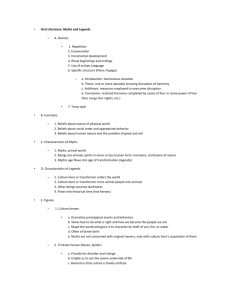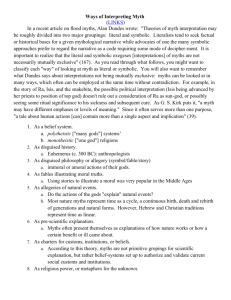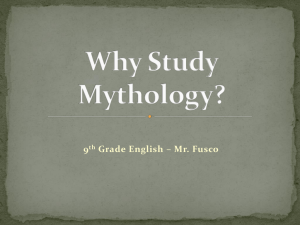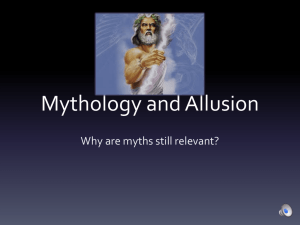What is a myth?
advertisement
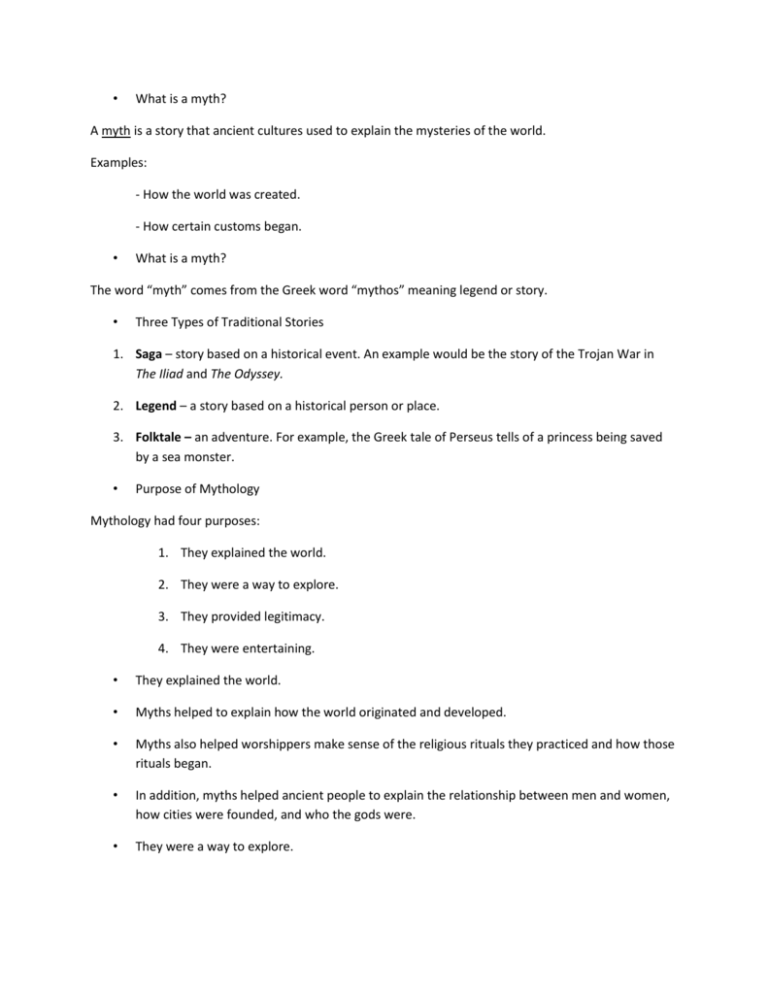
• What is a myth? A myth is a story that ancient cultures used to explain the mysteries of the world. Examples: - How the world was created. - How certain customs began. • What is a myth? The word “myth” comes from the Greek word “mythos” meaning legend or story. • Three Types of Traditional Stories 1. Saga – story based on a historical event. An example would be the story of the Trojan War in The Iliad and The Odyssey. 2. Legend – a story based on a historical person or place. 3. Folktale – an adventure. For example, the Greek tale of Perseus tells of a princess being saved by a sea monster. • Purpose of Mythology Mythology had four purposes: 1. They explained the world. 2. They were a way to explore. 3. They provided legitimacy. 4. They were entertaining. • They explained the world. • Myths helped to explain how the world originated and developed. • Myths also helped worshippers make sense of the religious rituals they practiced and how those rituals began. • In addition, myths helped ancient people to explain the relationship between men and women, how cities were founded, and who the gods were. • They were a way to explore. • Myths allowed people to explore the consequences of their actions. Stories of quests and tragedies helped people understand moral issues and religious obligations. • They provided legitimacy. • Legitimate - well reasoned and sincere • Myths helped ancient families trace their ancestry, making them legitimate by linking them to mythical ancestors. • They were entertaining. • Myths were a way to entertain people. • Epic tales and poems kept audiences captivated. • Some public performances drew crowds of 15,000 people. • How did the myths get passed down? • In ancient times, most myths were passed on by storytelling, or word of mouth. • Ancient people heard the stories over and over again from the time they were small children until they knew them by heart. • How did the myths get passed down? • They were acted out at festivals and in public performances, and women told myths to each other as they wove. • Myths have also been passed down through writing, rituals, dances, acting, and art • Types of Myths • Myths can be grouped into three different categories: – Cosmic Myths – Myths about gods – Myths of Heroes • Cosmic Myths • Cosmic Myths tell about the Earth, including the origin of the world, fires, floods and other natural disasters, as well as the afterlife. • The oldest cosmic myths are from Ancient Egypt and the Near East. • The Babylonians had a creation myth called Enuma elish (When on high) that dates back to the 12th century B.C • Myths about The gods • Ancient people associated the Earth, objects in the sky, and features of the physical world with the gods and goddesses of their cultures. • In many mythologies, there was a divine family made up of gods. • Many cultures tended to have the same type of gods, but with different names and characteristics • Myths of Heroes • Most mythologies also have myths about heroes. • Some heroes are mortals with one divine parent and others are totally human, but have godlike characteristics. • Myths of Heroes • Many myths about heroes are about the hero’s birth or a quest or journey and his or her return home. • One of the most famous hero myths is the Greek story of Odysseus – a hero who has been away from home for 20 years fighting the Trojan War.




